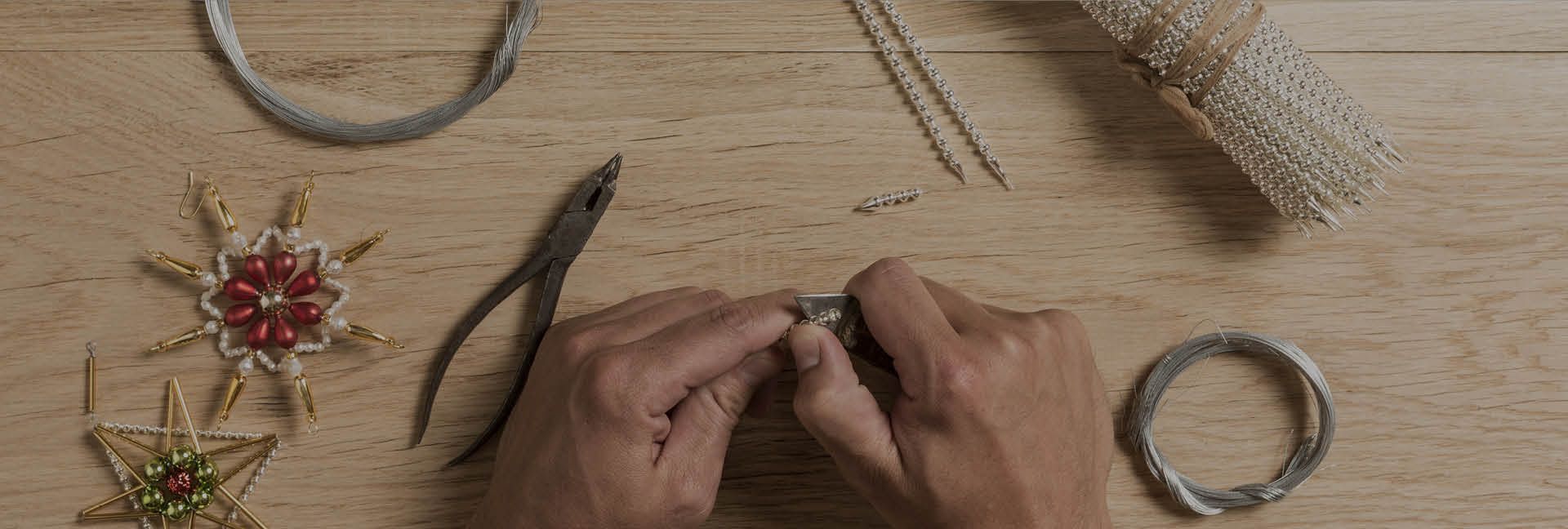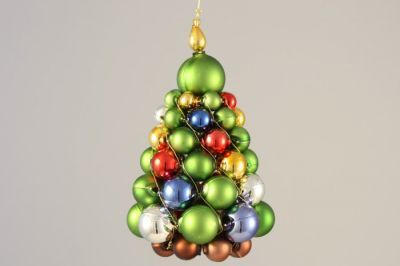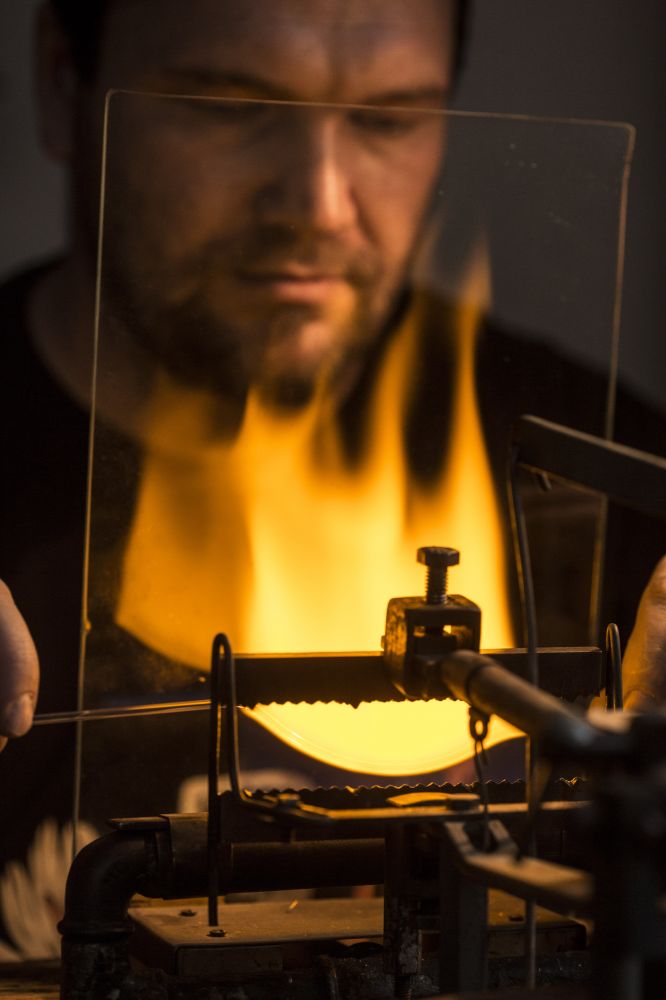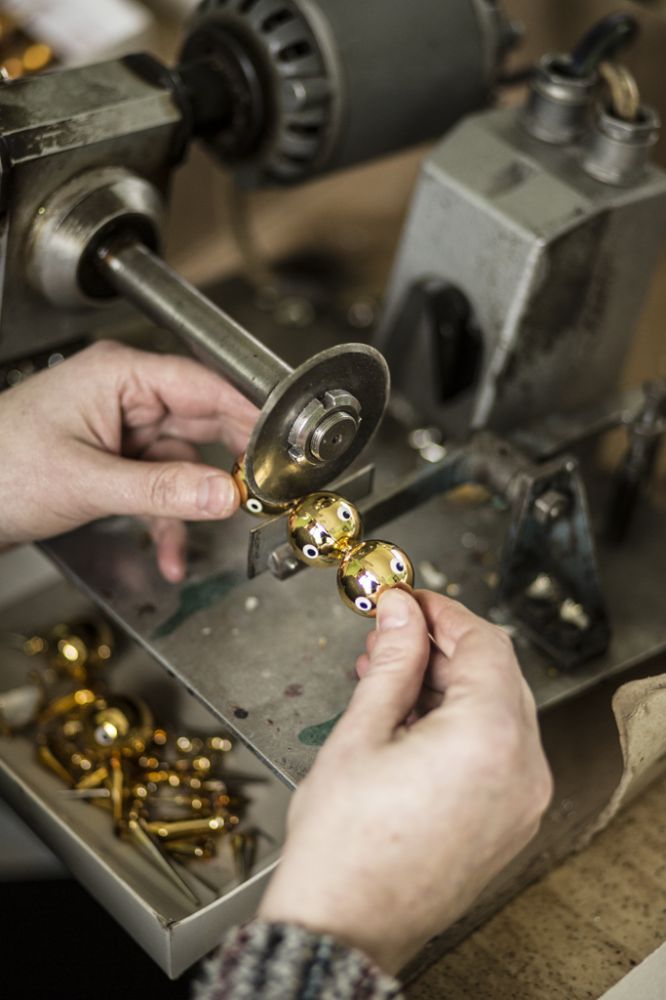I have decided to tell you my story. Who knows how would it end up if some human tried to tell it. My words might not be as nice, but I will tell you how I see it. You, modern people, you want to know exactly where and when everyone was born. I cannot tell you that. I do not remember, where it happened, or who was the first to blow into quartz mash, so I could shine for the first time. People say it might have been Krakonoš who wanted to give poor people from mountains so new way of livelihood. Well, as I said, I do not remember, so I cannot confirm that. I would say it was a real human who brought me to this world. I was just born from Earth gifts and human breath. My name is Blown Pearl, and this is my story.
People can make sense of time and numbers, but not us, beads. However, I have heard that they have been blowing me in the mountains for more than a hundred years. As a bead would put it, that is a long time. You, who have never seen how a bead is born, you don´t know how beautiful life can be. At the very beginning, it was quite an adventure, because some blower took a glass tube, he was turning it in a blue flame and then took a breath and blew into it. That´s how I was born! The only one. Then back to the flame, turn again and blow – and my sister was born. The skilful blower could make a full box of us – three and half thousand could fit in it by the evening. Truth to be told, each of us was a little bit different, but we were beautiful back then too. As a blower sometimes blew differently, various shapes of us were created. Some of my sisters were elongated, some pear-shaped and others were tiny. And people liked this diversity. They blew us from a clear and coloured, smooth or scalloped glass. However, they were still wondering how they could speed up the work. There were quite a few blowers in Josefův důl and one of them was a particularly smart guy, Josef Pitzek. He invented the blowing machine, which could produce o lot of us at once and of the same size. People did no longer blew by mouth; it operated with a pump and a pedal. We were born as “klaučata”, these are rows of beads produced from the whole tube – one by one – one next to each other. You know, it was hard work, and the blowers didn´t get much money by selling us. We used to crack sometimes, especially if the tubes were not decent with an uneven thickness of the walls, or if the blower was a slob who did not properly turn the tube in the flame.
Glass is beautiful, that´s for sure, but people wanted us to become something else. They wanted us even more beautiful. And that is how I learned that somewhere far away, at the bottom of the sea, different pearls are born. White, elusive, pearly – they are not made out of glass. I discovered people are willing to pay a pile of money. And therefore, local glassmakers decided to colour and adjust us in a way, so we looked as similar as the ocean pearls – nobody listened to us. People invented how to silver us from the inside. In the end, it was truly beautiful, but who have not experienced it, could not imagine the hardship that the bead makers went through. It was them, who had to take the “klauč” into their mouth and suck up the liquid that coloured us. These must have been strong quack remedies - extract of fish scales and various lead solution and later something called silver nitrate. Sometimes, while sucking the colour with “klauče”, a certain amount of liquid got into bead maker´s mouth. That was bad. These people noticed having dark spots on their faces - dark blue, even black. People who had been doing this for a long time looked like they had blue or black skin. Newspapers wrote about that, doctors were wondering. The saddest thing was that they were mostly old people or very young children. Perhaps, you would have thought that it´s all changed today. Not at all, the old Pitzek´s machine is not very different from the new modern ones. Silvering still remains alchemy, even though, people don´t do it by mouth. Blowing and silvering of “klauče” with beads is work that hasn´t changed much in a few centuries.
Who would say that people were satisfied with us being silvered inside - would be wrong. They coloured us from the outside as well. They soaked us in colour and then took out the whole “klauče” of us, impaled on a wire hedgehog and let us dry. Oh dear! What a bead has to go through. That is unbelievable. Later they started to paint on us with brushes and put all sorts of glitter on us, so we looked awesome. And we were still connected in “klauče”! Later came a time, for us to be separated. It has always been done with a hand knife, but today we use machines with discs, especially for bigger beads. That´s it. We are beautiful, ready to dazzle and spread the fame of Czech glassmakers all around the world. We have been doing this for a long time!
When small cut, grinded and lamp beads joined us, we became an army of beauty ready to become a part of famous jewellery from the Crystal Valley in the northern part of Bohemia. And I´ll tell you, these were beautiful and magnificent pieces, which were sold all over the world. We saw America, Africa and Asia, we sailed to the pyramids in Egypt and to see elephants in India. In the beginning, there was a great demand for us. Many trade and export houses were established in Jablonec, as well as showrooms. The business flourished. Then the crisis came, and Czech glassmakers were outsmarted by the Japanese who learned the bead production and started to make their beads. Somehow, we got stuck in the warehouses and felt bored. We didn´t know what would happen to us. Though, we did not have a bunch of small children, who need food all the time, or a house that needs reparations. People suffered more than us. That was the case of a beautiful broad village Poniklá at the edge of Krkonoše Mountains that I have intended to tell you about for some time.
Weaving has always been present here, yet it was very badly paid, and therefore, it was not possible to overcome poverty. When local people realized that blowing of beads earns more money, they started to replace looms with blowing tables. Soon, they were blowing beads in every house. It went well for some time, but when Czech beads stopped selling around the world, people came with something new to survive in the mountains. That is what I like about you, people – you never give up. You stick to living and always come up with some solution. And that is how it was at the beginning of the new century that you called the twentieth century. Do not expect me to understand. At that time, a new Christmas fashion came from Germany. People brought a tree from the forest, decorated it and then, on Christmas day, put on it and underneath it presents. First, they decorated the spruces and firs trees with everything they could find in the house - fruit, nuts, sweets, puppets, candles or paper chains. People wanted a richly decoaŕated tree. And it was different in every family. We don´t know the blower that came up with the idea to take a wire and then thread a failed bead on it, made it round and then hung on the tree. The warehouses were full of unsold beads, and local businessmen came with the idea to turn them into Christmas decorations. They started with different triangles, rhombuses, round suns and, of course, stars. As it turned out, we, hollow blown beads are the best as a decoration, so we became famous in a different way. No necklaces, brooches, hatpins, earrings or national costumes decoration, but decoration. We were light and beautiful decorations. Different shapes were added after that Great War, such as baby carriages, locomotives, spiders, handbags, planes, baby´s dummy or butterflies – all you can imagine.
I am lying here, in the paper box, and thinking back. I am looking around. I can see a lot of children putting aside small black boxes. They look inside them all the time, tapping them with fingers and sometimes even talk to them. I sometimes forget about them here. The put us on wires and their hands slowly create decorations. It is not just a tourist attraction! Yes, you understand – in Poniklá they have been producing Christmas decorations till today. They still make them in the same way as a hundred years ago. The house where I am currently waiting to be picked by some girl or boy is a centre. Glass tubes are delivered to other houses from here. There they are heated and blown, then brought back to the centre, where they colour them. After that, they travel to other houses, where they are cut, put on a wire and transformed into beautiful decorations. They call it “scattered manufactory” – I heard it from our Barbora. She says it is the only place in the world, where they produce decorations in the old way. They say that if it goes well, we might get on some famous list. Over there, you can see the decoration on the wall, decoration made of beads. People buy this decoration in our small shop and other shops all over the world. They buy decoration that looks the same way still. And I can tell you – the happiness we bring, when hanging on the tree, is still the same. We do not change - people do. However, happiness remains the same. And we need more.


 See & Experience
See & Experience















